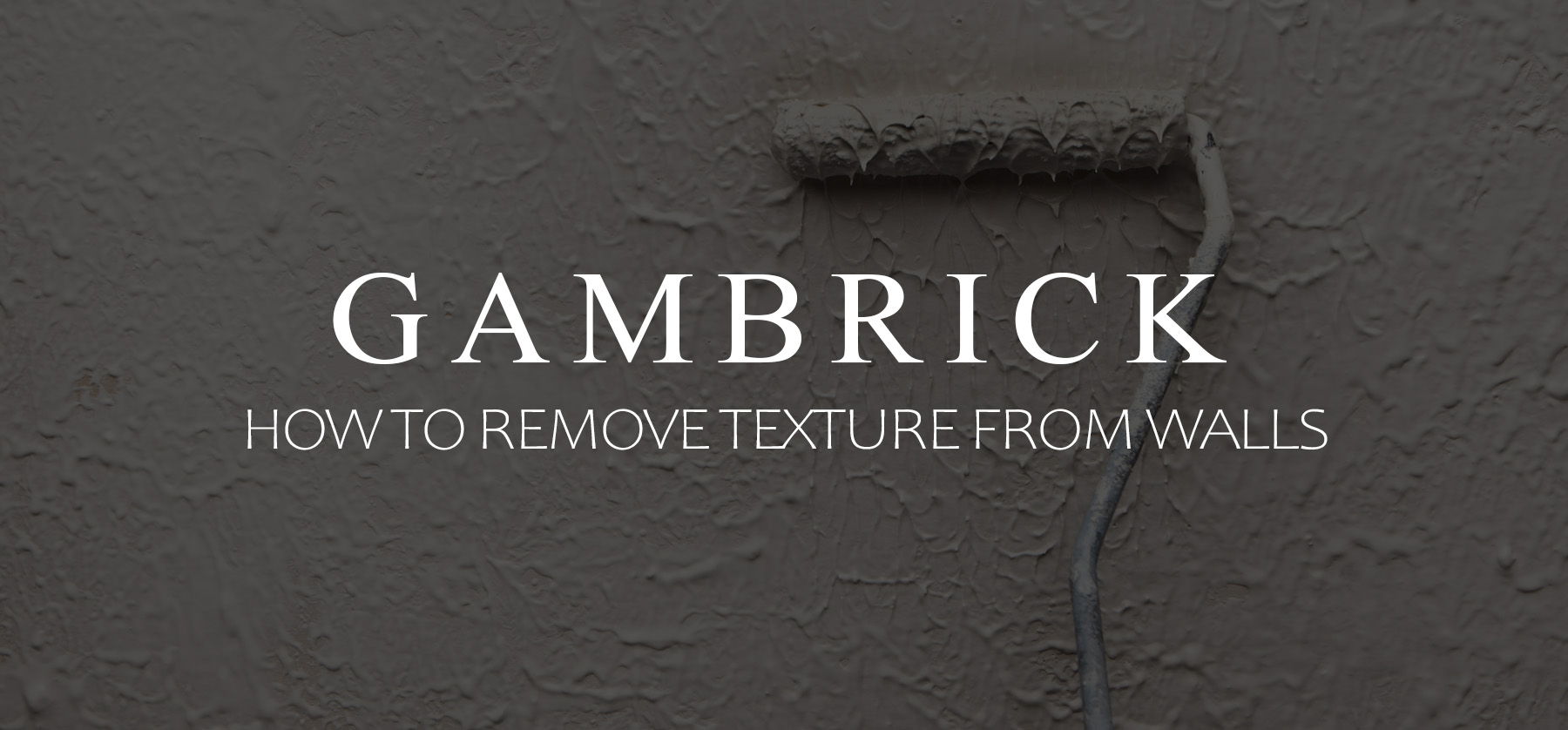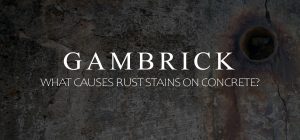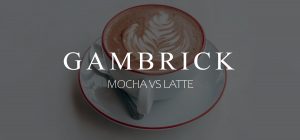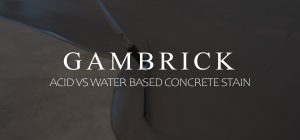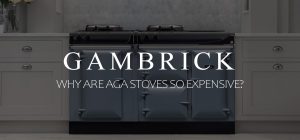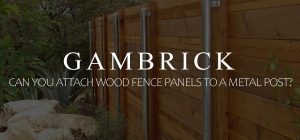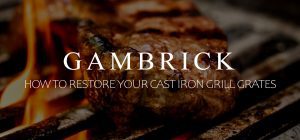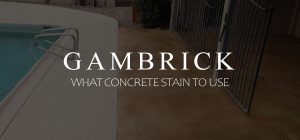How To Remove Texture From Walls
Texturing is an old fashioned way of adding interest to a wall. Have you ever seen the soft ripples of orange peel or the ridges and swirls of knock down. Both are examples of a textured finish. It’s a 3 dimensional look that adds shadow and highlights in place of the usual flat wall we’re used to seeing. Contractors start with a smooth wall and then apply a coat of compound on top to create an artistic look. It’s all done by hand which makes every job unique. But these days texturing is considered an outdated look that most people want to get rid of. So how do you remove texture from walls? There are three main ways: soak and scrape it off, cover it up with compound or paneling, or remove the drywall entirely.
Luckily it’s not that hard to remove a textured wall finish. Although it’s typically a messy and time consuming project. There are two main methods we use to remove texture from a wall no matter what style it is. Which works best depends on whether or not the walls have been painted.
- Unpainted wall texture can usually be removed with a soak and scrape process.
- Painted texture can be covered up with a thin layer of compound or wall board. Paint is a good sealant against water, so soaking doesn’t soften the texture enough to scrape it off.
- If you really want that painted wall texture removed and not skimmed with compound it’s possible. But it’ll take some time and muscle. Without softening the finish first it’s not easy to scrape off.
- In extreme situations you could also replace the drywall entirely.
Ahead we’ll look at each method we use to remove wall texture in detail.
What Are Textured Walls?
Textured walls are just like they sound. A flat wall that’s been given a texture. An installer starts with a flat wall and then applies a textured coating to it. These textures come in different general styles and have names like “orange peel” or “knock down”. But each application is different so the end look is always unique.
And textured interior walls are more than just for looks. They have a practical function too. Texturing is a great way to hide small imperfections on a wall. Because of all the noise created by the texture design you can’t make out a lot of little things that would otherwise stand out. It’s also fairly cheap to do which is an attractive option for some.
It’s also more durable than a smooth wall and less affected by minor wear and tear. The texture coat is harder than drywall so it holds up better. And you don’t see every little ding and scratch like you do on a typical flat wall because the texture helps hide it. That’s why we use texturing in most commercial properties like hotels and office buildings.
Although texturing is generally considered an outdated look. Some people still really love it. But these days it’s used more as an accent design or focal point than an every wall finish. Texturing one wall of a bathroom or around a fireplace can be a really nice look. It’s also a nice finish when paired with wall paneling like wainscoting because the wall is so much shorter.
How Is Wall Texturing Done?
Typically, texture is sprayed onto a flat wall after drywall and sanding is done. The wall beneath the texture should be a finished flat wall that’s ready for paint. But instead of painting a layer of texture is added instead.
After the texture layer is applied, you can paint the wall or leave it alone as is. This has a lot to do with how easy a textured wall is to remove. If you’ve got a textured wall that’s unpainted it’s easier to remove with a soak and scrape method. However if it’s been paint things get harder. You’ll either have to cover it up or spend a lot more time scraping.
Sometimes patterns are added to the texture design. This can be done with either a soft brush, rag, sponge or other tool. Many of these texture patterns even have names. For example, Santa Fe, orange peel, knockdown, swirl, or cat’s paw.
You can also apply ready made texture paint using a brush or roller. Popcorn is a common example of texture painting. You can either roll the popcorn on by including it in the paint or spray it on later.
Common Methods To Remove A Textured Wall
Below is our list of the most common methods we use to remove a textured wall along with lots of tips and tricks. We’ve also included some step by step instructions for you to follow on some of the harder methods.
Apply A Skim Coat
After drywall is installed, the fasteners and taped seams are covered up with joint compound or “mud” and then sanded down. This is often called a skim coat. The very same technique is used to remove textured walls. A thin coat of compound is applied over the entire wall surface, allowed to dry, and then sanded smooth.
The skim coat wills in all the gaps between texturing which creates a smooth surface. It’s very similar to old fashioned plastering or the cement coat on a foundation. A skilled contractor can get a wall just as smooth as drywall.
Skim coating an entire whole room can be messy and time consuming. Especially if you don’t know what your doing. This isn’t something for a beginner if you want a high level finish. Pros can do a job faster and much smoother so there’s almost no sanding. However, most amateur jobs need tons of sanding because they can’t float the compound smooth and even enough.
Once the new wall is smooth and dry, it can be sealed with a primer and then painted or finished as needed.
Step By Step
Here are step by step instructions on how we remove texture from a wall with a skim coat.
1. Remove The Trim
If the wall or trim’s been painted, cut the edges with a utility knife before prying the trim off. This will prevent the paint from peeling.
Then slip a small steel putty knife behind the trim and gently pry it off the wall. Make sure to pry against a stud if possible to avoid damaging the drywall. Tap the head of the putty knife with a hammer to help wedge it between the trim and wall if you have to.
2. Cover The Floor
Cover the floor with a canvas drop cloth. I don’t recommend using plastic because they can be slippery and break easily.
Tape the edges of the tarp down to the floor. This will help keep it in place as you work.
3. Sand The Surface
I always sand down the surface of a textured wall prior to applying the skim coat. This does two things. First, if there’s paint the sanding will remove the sheen. This helps the compound stick to the wall. Second, any high spots in the texture will be sanded down. Ideally what I want is for the entire textured wall to be about the same height. High spots make it much harder to get a smooth finish.
4. Wipe The Wall Clean
Once your done sanding make sure to wipe the wall down with a damp rag, cloth or paper towels. And dust will make it harder to apply the skim coat.
5. Mix The Compound
I like to buy premixed drywall compound in a 5 gallon bucket. It’s the exact same product we use for all of our drywall work. But it generally comes a little stiff and is much easier to work with if you mix it yourself prior to use.
Mix about a gallon of compound at a time in a different 5 gallon bucket. Add a little bit of water at a time as you mix the compound with a paddle bit. You want a pancake consistency that’s very smooth and free of lumps. Add water slowly, a little goes a long way since it’s already been mixed at the factory. This site mixing just gets it a little smoother and easier to work with but you don’t want it overly wet.
6. Apply The Compound
Some contractors roll the compound on first with a large roller and some apply it with a wide knife. I prefer to apply if with the knife just like old fashioned plaster work. Rolling it on can be very messy.
If you prefer to roll it on then you’ll have to go over it all with a wide knife anyway. This gives the finish a super smooth look.
However you apply your compound the first time, make sure you smooth it slowly with your knife as flat as possible.
Try to maintain a wet edge. This takes some time to get right, especially on a big wall, but it’s best to plaster an entire wall without stopping.
7. Let The Compound Dry. Sand. Apply Second Coat.
It’s important to completely let the compound dry before you do anything further to it. Once it’s dry you can take a closer look and access what comes next. Unless your a master plasterer, you’ll probably need a second coat.
Before you apply it, make sure to sand down the first one with a medium grit sandpaper. Get the wall as smooth as possible and then wipe it down. Now carefully go over the entire wall with the same wide knife. The second coat should fill in any small imperfections and correct any unevenness.
8. Final Sanding
Once the final coat of plaster is applied it’s time for a final sanding. This time I use a fine grit sandpaper. Go over the entire wall and get it super smooth.
9. Final Inspection
I always review my work at the very end to make sure it’s all been done exactly how I want it. If you find small imperfections this is the time to fix them. Apply compound, smooth, sand etc. as needed until the finished product is smooth and ready for paint.
Pro Tips
- I like to use a sanding sponge for my last coat rather than a pad. The surface is now 100 percent drywall compound which means the edges of a sanding pad can gouge and leave marks. Use light pressure and sand in circles.
- If you use a sanding pad, make it as wide as possible. I’d buy one that was 8′ wide for an 8′ wall if I could. This helps maintain a smooth and consistent finish.
- Always sand with very little pressure. Let the sandpaper do the work. Drywall compound is very soft and doesn’t need much pressure. Generally just grazing the surface is enough.
- Be very careful not to apply compound too thick. Ideally you want the surface to be the same as the old texture. If you pack on too much compound the wall will be thicker which means you’ll have to adjust the window and door jambs.
- Be careful around the edges of a wall. When your sanding close to an adjacent wall it’s very easy to scratch of even gauge it with a sanding pad. The final skim coat is delicate work.
- Be sure to wear a mask. Sanding an entire wall of compound and texture can create a lot of dust.
- Use a bright work light on the wall. Lots of light makes it easier to find imperfections.
- Feel the wall with your fingers. Some times you can find small imperfections and unevenness with your hands that you can’t see until the wall is painted.
Soak And Scrape The Texture Off
Soaking and scraping is a great way to remove texture from walls. However it works best when the wall texture is unpainted. Paint is generally resistant to water which makes it much harder to soak.
If your walls are painted you should try to sand them down with a hard grit sandpaper first. This can not only grind down some of the texture but also the paint.
Once the wall is sanded, soak and scrape as best you can. In areas where enough paint was removed the water will absorb and the texture will come off easier. However, if areas where paint didn’t come off, you’ll have to do more scraping and less soaking. It’s harder and more time consuming but it still works.
Step By Step
Here are step by step instructions on how we remove unpainted texture from a wall with a soak and scrape process.
1. Remove The Trim
If the wall or trim’s been painted, cut the edges with a utility knife before prying the trim off. This will prevent the paint from peeling.
Then slip a small steel putty knife behind the trim and gently pry it off the wall. Make sure to pry against a stud if possible to avoid damaging the drywall. Tap the head of the putty knife with a hammer to help wedge it between the trim and wall if you have to.
2. Cover The Floor
Cover the floor with a canvas drop cloth. I don’t recommend using plastic because they can be slippery and break easily.
Tape the edges of the tarp down to the floor. This will help keep it in place as you work.
3. Soak The Wall
Most contractors use a water bottle sprayer with a sponge. Warm water tends to work best and is easier to work with on your hand. As you spray, use the sponge to catch drips and help soak the wall.
You may have to spray the wall two or three times in order to fully soak it. Give the wall about 15 minutes to soften up and absorb the water. Test it with your fingernail before you start scraping. If it’s soaked enough you should be able to remove pieces by hand.
4. Start Scraping Off The Wall Texture
Ultimately, the way to remove texture from walls is by scraping it. The water just makes it easier to scrape.
Start at the top of the wall. As you go pieces will drop down from top to bottom. Clean the wall as you move down and remove fallen chucks as well as new texture. I like to use the same 10 inch drywall knife to scrape as I did to apply the compound. However in some areas that didn’t soften as much it can be easier to use a smaller knife.
To remove texture without gouging the drywall, hold the blade approximately 30 degrees to the wall. Scrape slowly and carefully. You don;t want to damage the wall.
If the knife meets resistance, stop and spray the area again until it softens up some more.
As you remove texture from walls, keep spraying as you go. I like to work in medium sized areas rather than on an entire wall all at once. Whenever I’ve tried to soak an entire wall it always dries out and then I just have to wet it again anyway. Now I wet as I go.
5. Let It Dry
Once all the soaking and scraping is done, let the wall dry out as needed.
6. Sanding
When you remove texture from walls, it hardly ever leaves behind a perfect finish. Sanding is a very important step if you want a smooth finish. Use a medium-hard grit sandpaper at first and get off any remaining bits of texture. They should sand right off. Don’t use too much pressure or your risk damaging the wall.
This sanding step is just to remove texture from walls, not to smooth the entire wall, that comes later.
7. Finish Work
The final step when you remove texture from walls is to finish the wall. In the end the goal is to have a smooth wall rather than a textured one. In this case you’ll have to apply joint compound as needed to fill any holes, scratches, dents, imperfections, etc.
Apply compound as needed, let it dry and then sand the wall again with a medium grit sandpaper. When the wall is smooth and all repairs are done, give it one more final sanding with a fine grit paper. This final sanding is what really gets the wall smooth and ready for paint.
Pro Tips
- Use as wide a sanding pad as possible. This helps get a smooth and even finish across large areas.
- Always sand with very little pressure. Let the sandpaper do the work. Drywall compound is very soft and doesn’t need much pressure. Generally just grazing the surface is enough.
- However, if your sanding down texture you can use more pressure. Especially if the texture has been painted. Don’t worry at this point if you damage the drywall because you’ll be repairing it later anyway.
- Be very careful not to apply repair compound too thick. You want to repair damage in the wall, not build up the surface.
- Be careful around the edges of a wall. When your sanding close to an adjacent wall it’s very easy to scratch of even gauge it with a sanding pad.
- Be sure to wear a mask. Sanding wall compound and texture can create a lot of dust.
- Use a bright work light on the wall. Lots of light makes it easier to find imperfections.
- Feel the wall with your fingers. Some times you can find small imperfections and unevenness with your hands that you can’t see until the wall is painted.
Replace The Textured Drywall
In some cases, replacing the textured drywall with new drywall can be the less expensive option. Skim coating an entire room can be an expensive job. It all depends on the type of texture used, how thick it is and how extensive.
If the texture is very heavy and painted, it’s probably better to demo and replace all the drywall. The time and effort it would take to sand it all down and scrape it off would generally cost more than replacement. And thick texture can be hard to remove. Sometimes it can stick so hard that removal takes chunks of drywall with it.
If you decide not to remove thick texture and want to do a skim over coat, that compound will have to be very thick. Overly thick compound is prone to cracking and generally isn’t a good idea in large areas. It’s also very heavy, harder to work with an expensive.
Then there’s the wall thickness to consider. If you build up a wall with thick texture it’ll end up being a pretty thick wall. This could mean adjustments to the trim work will be required. Sometimes the best way to remove texture from walls is to remove all the drywall instead.
Cover Up The Walls
If you don’t want to remove texture from walls, a viable alternative is covering them up.
Wood paneling is is very popular these days. Not the old style wood that was used in the 70’s. Today’s wall paneling designs are fresh and modern. There’s also lots more stone and brick being used on interior walls. Thin stone and brick veneer mixed with wood is a beautiful design we’re using in a variety of homes.
The Modern Farmhouse is a very popular home design at the moment. Shiplap and wainscoting are great ways to cover up a textured wall.
Keep in mind that when you pack out a wall like this you also effect other things like trim. Generally when we do this we remove all the trim, install the new wall coverings and then re-trim the room. This gives the best finished product.
Also little things are effected like outlets and switches. If you pack out a wall 2 inches you also have to move the switches and outlets. Radiators and vents are another issue. If you have them next to the wall then they’ll have to be adjusted too. This could then involve plumbing and vent work. Every job is different but it can sometimes be an expensive option.
Embrace It
If you don’t want to remove texture from walls but don’t love what you’ve got, a final suggestion is to embrace the look. Design around the texture and incorporate it into your new design. Maybe it’s not the texture you hate but the color or overall look of the room. Very often in our design business we can find ways to design around a wall texture and make it really pop.
We also do things in combination. For example, you may not have to remove all the texture. If we add some wainscoting, stone or new trim work, then the texture sometimes really works when there’s less of it. The new surrounding elements effects how it looks too.
Try hanging some cool artwork or posters on the wall. They’re a great way to cover up a wall without actually doing anything.
Use decor as a way to distract from the walls. If a room is styled beautifully then no one will be focused the walls. Most people who have textured walls, and hate them, pend too much time worrying about how they look.
Consider the paint color and sheen carefully. Some colors hide textures better than others. In my experience dark colors are great for this,although the room has to be right for them. I’ve also had great experience using grey and some creams. I don’t recommend white. I like softer warm colors that help smooth out the bumps.
Summary: How To Remove Texture From Walls
Texturing is an old fashioned way of adding interest to a wall. Have you ever seen the soft ripples of orange peel or the ridges and swirls of knock down. Both are examples of a textured finish. It’s a 3 dimensional look that adds shadow and highlights in place of the usual flat wall we’re used to seeing. Contractors start with a smooth wall and then apply a coat of compound on top to create an artistic look. It’s all done by hand which makes every job unique. But these days texturing is considered an outdated look that most people want to get rid of. So how do you remove texture from walls? There are three main ways: soak and scrape it off, cover it up with compound or paneling, or remove the drywall entirely.
Luckily it’s not that hard to remove a textured wall finish. Although it’s typically a messy and time consuming project. There are two main methods we use to remove texture from a wall no matter what style it is. Which works best depends on whether or not the walls have been painted.
- Unpainted wall texture can usually be removed with a soak and scrape process.
- Painted texture is most often covered up with a thin layer of compound. Paint is a good sealant against water, so soaking doesn’t soften the texture enough to scrape it off.
- If you really want that painted wall texture removed and not skimmed with compound it’s possible. But it’ll take some time and muscle. Without softening the finish first it’s not easy to scrape off.
If you have any questions or comments e-mail us any time. We’d love to hear from you.
